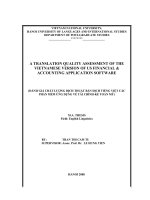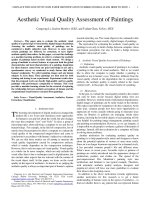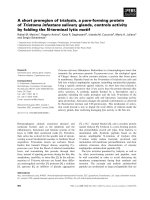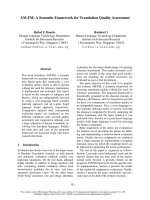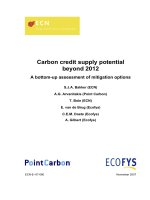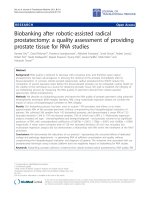A translation quality assessment of the first three chapters of the novel The da Vinci code by Do Thu Ha (2005) based on J.House's model
Bạn đang xem bản rút gọn của tài liệu. Xem và tải ngay bản đầy đủ của tài liệu tại đây (157.83 KB, 4 trang )
A translation quality assessment of the first
three chapters of the novel "The da Vinci code"
by Do Thu Ha (2005) based on J.House's model
Đặng Thị Phượng
Trường Đại học Ngoại ngữ
Luận văn Thạc sĩ ngành: English Linguistics; Mã số: 60 22 15
Người hướng dẫn: Assoc.Prof.Dr. Trần Xuân Điệp
Năm bảo vệ: 2012
Abstract. Literary translation has been developing for a long time; however, the
definition of a “good” translation still remains a controversy. Different theorists
construct different models to assess the quality of a translation text; therefore, there
exists only “good” translation according to a specific view. This qualitative study
attempts to evaluate the translation quality of the first three chapters in the Vietnamese
version of the novel “The Da Vinci Code” translated by Do Thu Ha (2005) based on J.
House’s translation quality assessing model. Under qualitative method, the source text
has been analyzed in the light of Halliday’s functional grammar (under five dimensions
namely Field, Tenor, Mode, Transitivity System, and Theme) and House’s model
(under two dimensions namely Dimensions of Language Use and Dimensions of
Language User). Besides, a comparison between the source and translation text has been
implemented to discover the mismatches and errors (namely covert and overt erroneous
errors). Thence, a statement of quality of the translation text has been presented, i.e. the
translation text is of rather poor quality and fails to exactly and completely convey the
interpersonal and ideational meaning of the source text (ST) according to House’s
model.
Keywords. Phương pháp giảng dạy; Tiếng Anh; Dịch thuật; Bản dịch
Content
I. Rationale of the study
There are various areas in translation among which translation quality assessment is a
subject of interest. To what degree a translation text is “good” all depends on a large variety of
factors, one of those would be the angle from which the translation text can be looked at.
Translation theorists developed their own models of translation quality assessment (TQA);
however, J. House’s is widely adduced for its applicability. J. House is a German linguist who
has developed her own TQA model after criticizing previously proposed ones by other linguists
like Newmark’s or Hatim & Mason’s. This paper is conducted based on her TQA model to
assess the first three chapters of the novel “Mật mã Da Vinci” by Đỗ Thu Hà (2005). This
translation work has raised a heated controversy over its quality among various translators and
readers. Tran, T.C.D, a famous translator, in his article “Bản dịch Mật mã Da Vinci: Một thảm
họa dịch thuật” in the newspaper “Văn Nghệ” (as cited in />%C4%91oc-la-thay-loi/152/7153208.epi), indicates that the translation version is the result of the
translator’s lack of knowledge of language, history, and religion in combination with her
carelessness, laziness and the publisher’s irresponsibility and shamelessness. Another article
discussing this issue is “Mật mã Da Vinci dịch ẩu, NXB VHTT nói gì?” Retrieved from the
website />gi/70027621/181/, this article also argues that the translation text contains numerous errors such
as vocabulary, grammar, expression, and obmission, etc. Nonetheless, several scholars such as
Thái Bá Tân, Vũ Thế Khôi and Lê Bầu (as cited in />binh/dich-thuat/2005/11/3b9acaf9/) hold that the quality of “Mật mã Da Vinci” is not that poor
and it should not be considered to be a “catastrophe” though there are noticeable mistakes in it.
Hence, the conductor of this research wishes to employ a recognized model of TQA in order to
evaluate the translation quality of the first three chapters of this novel to contribute a voice to the
controversy raised.
II. Scope and objectives of the study
Under the constraints of time and size, the study only focuses on the first three among
105 chapters in the book “Mật mã Da Vinci” by Đỗ Thu Hà in 2005. In this study, the
investigated chapters will be analyzed under the light of J. House’s approach of TQA in order to
reach the objectives of (1) discovering the features of the source text (ST) in the light of
Halliday’s functional grammar and House’s dimensions and (2) assessing the level of quality that
the translation text reaches. Due to the fact that House’s model is constituted based on pragmatic
theories of language use meanwhile concerning semantic and textual aspect, the scope of this
study is not limited as its title may arouse. The paper covers quite a large range of applied
linguistics, for example, constrastive analysis, cross-cultural study, functional grammar, and
translation.
III. Research questions
In order to fulfill its objectives stated above, this paper needs to answer the following
research questions:
1. What are the features of the ST in the light of Halliday’s functional grammar and
House’s dimensions?
2. To what degree does the translation text (TT) meet the standard of quality as proposed
in House’s TQA model?
IV. Research methodology
- Qualitative method: This research is a qualitative evaluation; hence, the source of data
is document, and information is gathered by an analysis of documents and materials. Data are
categorized into patterns as the primary basis for organizing and reporting results. Qualitative
method allows the researcher to study individual text closely. It also enables multiple analytic
strategies.
- Synthetic and analytic methods: The analysis of the texts is also approached from the
combination of analytic and synthetic methods: analytic perspective to identify, isolate certain
aspects to concentrate on, and synthetic perspective to investigate the interdependence of these
constituents – how they work together as a whole.
- Descriptive and comparative methods: In order to provide in-depth and detailed
descriptions of translation and evaluation, the study is descriptive and comparative in nature.
V. Organization of the study
The first part of the study is the Introduction which provides a general view of the
research such as methods, objectives, and scope.
In the second part – Development, the study aims to present the theoretical background of
the research (Chapter I) and review the existing literature by presenting some related concepts of
translation theory and typical TQA models (Chapter II). Chapter III focuses on the Methodology
and Procedures of the research. Chapter IV is the Findings and Discussion which present the
results of data analysis and discussions.
In part 3, the conclusion of the study will be stated with three components: Recapitulation
of the study, Limitation of the study, and Recommendations for further research.
References
1. Almeida, L. & Nascimento, S. (1996). Assessment of the Quality of Contract Translation.
1996. Unpublished MSc Dissertation. Florianópolis: UFSC.
2. Baker, M. (1992). In Other Words: a Coursebook on Translation. London: Routledge.
3. Catford. (1964). A Linguistic Theory of Translation. Oxford: OUP
4. Duff, A. (1989). Translation. Oxford: OUP.
5. Hatim, B. & Mason, I. (1990). Discourse and the Translator. London: Longman.
6. Hoang, V.V. (2006). Translation: theory and practice. Educational Publisher.
7. House, J. (1997). Translation Quality Assessment: A Model Revisited. Gunter Narr, Tubingen.
8. House, J., (2001). Translation Quality Assessment: Linguistic Description versus Social
Evaluation”, Translators' Journal, vol. 46, n° 2, p. 243-257."
9. House, J. (2006a). Text and Context in Translation. Journal of Pragmatics 38. 338-358.
10. Jakobson, R. (1959). On Linguistic Aspects of Translation, in R. A. Brower (ed.) On
Translation, Cambridge, MA: Harvard University Press, pp. 232-39.
11. Jun, T. & Yan, W. (2011). Application of House's Translation Quality Assessment Model in
C-E Translation - A Case Study of „The Sight of Father's Back‟ by Zhu Ziqing. Journal of Hefei
University of Technology (Social Sciences): 2011-06
12. Le, M. H. (2010). A translation quality assessment of the Vietnamese version of part 7
“Nightmare” in the novel “Twilight” using House‟s model. MA thesis. ULIS, VNU.
13. Luong, T.L. (2007). Application of House‟s model for translation quality assessment in
assessing the English version of the Vietnam‟s Law on Investment No 59/2005/QH11. MA thesis.
ULIS, VNU.
14. Munday, J. (2001). Introducing Translation Studies. Routledge: London & New York.
15. Nazhand, N. & Pur, M. M. (2011). House's Model Application to Faulkner's book Translated
by S.Hosseini: The Application of House's Model to William Faulkner's "The Sound and the
Fury" and its Persian Translation by Saleh Hosseini (Paperback). Saarbrücken, Germany: VDM
Verlag Dr. Müller.
16. Newmark, P. (1981). Approaches to translation. Oxford: Pergamon.
17. Newmark, P. (1988). A textbook of translation. Hertfordshire: Centre for Translation &
Language Studies, University of Surrey.
18. Nguyen, T.Y. (2007). Evaluating the translation of the travel guidebook “Du lich Ha Long”
based on house‟s approach. MA thesis. Hanoi: ULIS, VNU.
19. Nida, E. A. 1964. Towards a Science of Translating. Leiden: E. J. Brill.
20. Reiss, K. (1971). Possibilities and limitations of translation criticism. Munich: Hueber.
21. Wills, W. 1982. The science of translation, Problems and methods. Tübingen: Gunter Narr.
22. Yamini, H. & Abdi, F. (2010). The Application of House‟s Model on William Shakespeare‟s
„Macbeth‟ and its Persian Translation by Ala‟uddin Pasargadi. Translation Directory Journal
June 2010. Retrieved August 10
th
2012 from
23. Tran, T.C.D. (2006). Bản dịch Mật mã Da Vinci: Một thảm họa dịch thuật. Ha Noi: Văn
Nghệ Newspaper. Retrieved August 10
th
2012 from />%C4%91oc-la-thay-loi/152/7153208.epi)
24. Mật mã Da Vinci dịch ẩu, NXB VHTT nói gì? Retrieved August 10
th
2012 from
25. Sách dịch – Đáng báo động mà chưa có giải pháp. Retrieved August 10
th
2012 from


